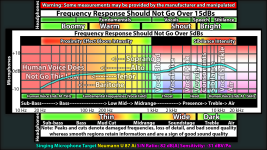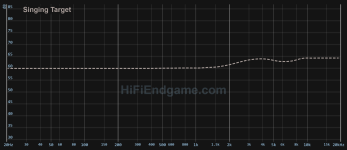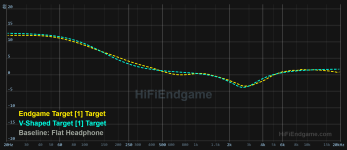- Joined
- Jul 2, 2024
- Messages
- 351
- Reaction score
- 39
This website uses a target named the Endgame Target. Why is it called endgame? Well because a lot of people in the audio hobby claim to want to find the best headphone, IEM, or microphone and move on with their life. What usually happens is they buy more and more audio equipment having no idea what they're doing or how to stop. They end up wasting tons of money buying things based on hype and word of mouth rather than having any form of critical thinking skills to figure it out and be done with it. This is where the "Endgame Target" is here to help.
The endgame target originally started many years ago focused primarily on microphones. I was recording YouTube videos for a very long time and was never happy with how my recordings sounded. Years and years of daily recording with lots of different microphones allowed me to understand how to hear the tonality of microphones very well. If there was any defects in the frequency response, I could hear it. Some call it listening fatigue. Where you pick up on a bad tonality and over time it wears away at you. This allowed me to slowly grind away at the sound of microphones and narrow in on an optimum frequency response for spoken word microphones. I created the guide below from scratch and the target as well:

This target can be seen on many industry standard lavalier, shotgun, broadcasting dynamic, and studio condensers for spoken word. Flat mids and a broad treble bubble for a smooth bright open clear articulate sound. I learned over time that any peak, cut, or tilt in the frequency response is audible and to avoid it. For fun I came up with another optimum target for vocal singing which has tilted mids for a forward thin cut through the mix sound when singing:

This singing target sounds unnatural but is what a lot of companies shoot for when making vocal singing tube microphones especially. It does not fit my application of spoken word so I avoid this tuning completely but it is still worth mentioning. The targets look like the below images without a bass or air roll off since there are so many variations in tuning decisions that are acceptable.


I never really cared too much about output devices like headphones or IEMs since I only cared about my recordings. I was willing to suffer with listening to bad headphones. I was met with a challenge to find the best headphone one day. I used my knowledge of microphones to try to find the best headphone. I looked for frequency response databases similar to https://recordinghacks.com/ but for headphones and IEMs. I found a lot of measurements but they were hard to read and confusing. It wasn't until I came across Sonarworks that I found a measurement database that I could read. Next thing you know, I bought a few headphones based on their measurements and learned from my mistakes as I went along.

I took all the tuning secrets I could analyzing the graphs and eventually came up with this:

Some people criticize me for never changing or updating my targets over the past few years and that's because I know what I'm doing so I don't need to adjust it. I used my ears, industry leading tuning techniques, and easily found the optimum response within a few months. I know I did it right because I have ears and use them. Golden ears. This tuning I came up with is actually widely used and commonly called Fun, V-Shaped, Dynamic, or Excited depending on the company's EQ preset.


I am shocked and alarmed by how bad people in this industry are at audio. Lately I've seen people muddying the waters further with new measuring rigs and targets making things even more confusing for everyone involved. This is how the endgame target was born.
The endgame target originally started many years ago focused primarily on microphones. I was recording YouTube videos for a very long time and was never happy with how my recordings sounded. Years and years of daily recording with lots of different microphones allowed me to understand how to hear the tonality of microphones very well. If there was any defects in the frequency response, I could hear it. Some call it listening fatigue. Where you pick up on a bad tonality and over time it wears away at you. This allowed me to slowly grind away at the sound of microphones and narrow in on an optimum frequency response for spoken word microphones. I created the guide below from scratch and the target as well:

This target can be seen on many industry standard lavalier, shotgun, broadcasting dynamic, and studio condensers for spoken word. Flat mids and a broad treble bubble for a smooth bright open clear articulate sound. I learned over time that any peak, cut, or tilt in the frequency response is audible and to avoid it. For fun I came up with another optimum target for vocal singing which has tilted mids for a forward thin cut through the mix sound when singing:

This singing target sounds unnatural but is what a lot of companies shoot for when making vocal singing tube microphones especially. It does not fit my application of spoken word so I avoid this tuning completely but it is still worth mentioning. The targets look like the below images without a bass or air roll off since there are so many variations in tuning decisions that are acceptable.


I never really cared too much about output devices like headphones or IEMs since I only cared about my recordings. I was willing to suffer with listening to bad headphones. I was met with a challenge to find the best headphone one day. I used my knowledge of microphones to try to find the best headphone. I looked for frequency response databases similar to https://recordinghacks.com/ but for headphones and IEMs. I found a lot of measurements but they were hard to read and confusing. It wasn't until I came across Sonarworks that I found a measurement database that I could read. Next thing you know, I bought a few headphones based on their measurements and learned from my mistakes as I went along.

I took all the tuning secrets I could analyzing the graphs and eventually came up with this:

Some people criticize me for never changing or updating my targets over the past few years and that's because I know what I'm doing so I don't need to adjust it. I used my ears, industry leading tuning techniques, and easily found the optimum response within a few months. I know I did it right because I have ears and use them. Golden ears. This tuning I came up with is actually widely used and commonly called Fun, V-Shaped, Dynamic, or Excited depending on the company's EQ preset.


I am shocked and alarmed by how bad people in this industry are at audio. Lately I've seen people muddying the waters further with new measuring rigs and targets making things even more confusing for everyone involved. This is how the endgame target was born.
Attachments
Last edited:





